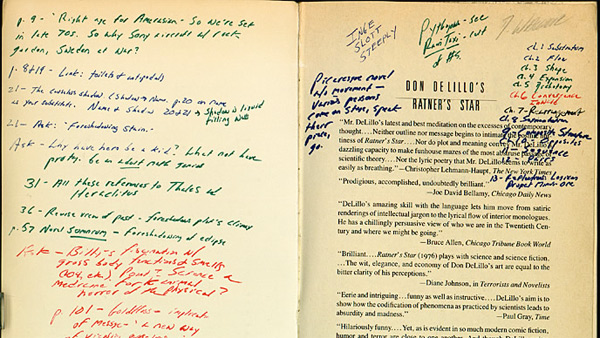A new novel by the late David Foster Wallace, set in an Internal Revenue Service office in Illinois, will be published April 15, Tax Day. Titled “The Pale King†, the book was was unfinished when the author committed suicide two years ago this month, at age 46.
The first think I read of his was his essay “Consider the Lobster,”.a masterwork that morphed from a scene piece about a festival in Maine into an essay about whether it’s ethical to boil lobsters alive (short answer: no). But it was, of course, his 1996 novel “Infinite Jest” that he was best known for – his magnum opus – set in a tennis academy and a nearby drug rehab in a parodic version of Organsation of North American Nations, or ONAN. It is set against a near-future background in which the U.S., Canada and Mexico have merged, Northern New England has become a vast toxic waste dump and everything from private automobiles to the very years themselves that are sponsored by corporate advertisers to become “The Year of the Depend Adult Undergarment†and “The Year of Dairy Products from the American Heartland.” “Infinite Jest†is a lost film cartridge that is so entertaining, unwary viewers lose interest in everything else in life. “Infinite Jest†was that book that every young man was conspicuously lugging around (it’s 1000 pages) that year, and cemented Wallace’s reputation as a major American literary figure. The hefty tome was praised for its complexity and dark wit, a vast investigation into America as the land of addictions: to television, to drugs, to loneliness. Time magazine named it in its issue of the “100 Best English-Language Novels From 1923 to 2005″ and was awarded the MacArthur Foundation “genius grant in 1997. His books and essays inspired a generation of writers and forever altered the literary landscape.
Besides “Infinite Jest”, Wallace was defined by his crippling and ultimately deadly depression, that was unresponsive to every kind of medication and treatment including electro-shock therapy and multiple hospitalizations. His depression was like a cancer, untreatable, unrelenting and terminal. His insomnia and  debilitating anxiety made him unable to write or socialize and he was granted a medical leave from Pomona College where he taught. Depression often figured in his work, but he never wrote about his own. In “The Depressed Person,†a short story about an unhappy narcissistic young woman—included in Wallace’s 1999 collection, “Brief Interviews with Hideous Menâ€â€”he wrote,
“Paxil, Zoloft, Prozac, Tofranil, Wellbutrin, Elavil, Metrazol in combination with unilateral ECT (during a two-week voluntary in-patient course of treatment at a regional Mood Disorders clinic), Parnate both with and without lithium salts, Nardil both with and without Xanax. None had delivered any significant relief from the pain and feelings of emotional isolation that rendered the depressed person’s every waking hour an indescribable hell on earth.â€
In an interview in Salon during his book tour for Infinite Jest, Wallace said about the book:
There’s something particularly sad about it, something that doesn’t have very much to do with physical circumstances, or the economy, or any of the stuff that gets talked about in the news. It’s more like a stomach-level sadness. I see it in myself and my friends in different ways. It manifests itself as a kind of lostness. Whether it’s unique to our generation I really don’t know.
Photo: David Foster Wallace’s notes in his copy of Don Delillo’s “Ratner’s Star.” Credit: Harry Ransom Center.


